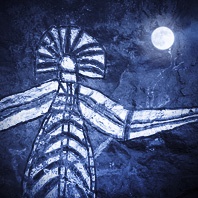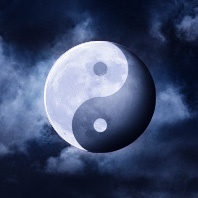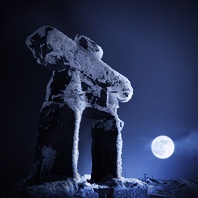Tag:
Mythology
In 2020 the full moon will fall on a 31st October and a Halloween party can take place in the full moon light. The imagination of people fits this well apparently, because no matter where you look, the full moon can be seen in all portrayals of Halloween. In historical terms, there is no connection, however. Halloween is the evening before All Saints’ Day (originally: »All Hallows’ Eve«). The basic idea of this festival is the remembrance of saints and it is connected to the wish to drive out bad spirits. This is how the gruesome costumes came into play.
Read more
This disk, made of bronze and gold, with an age of around 3,600 years, belongs to the oldest find representing astronomical phenomena and thereby depicting planets and stars in the sky. It is thus of great value, because it is evidenced that people of the Bronze Age (2200-800 BC) did not only possess manual skills to create such a refined metal disk, but above all, had the knowledge about astronomical processes. They observed the celestial events with the naked eye and portrayed this in an artistic form.
Read more
In China, the September full moon is a special day. It is the day of the Moon Festival or Mid-Autumn Festival. This festival is traditionally celebrated on the 15th day of the eighth month of the old Chinese calendar. Because the moon month averages 29.5 days in length, the 15th day is usually a full moon day, however, there are slight shifts in some years. The Moon Festival is one of the most important festivals in China, but is also held in Korea and Vietnam as well as in the respective districts in big cities around the globe.
Read more
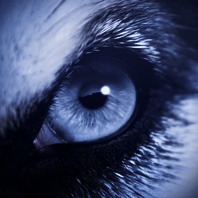 We are approaching a more sinister subject, the werewolf, a being that apparently changes from human into a wolf on the full moon. Everyone has heard about it or seen more or less plausible interpretations in movies. Where does this belief stem from? Why a wolf of all animals? And why in the full moon light?
We are approaching a more sinister subject, the werewolf, a being that apparently changes from human into a wolf on the full moon. Everyone has heard about it or seen more or less plausible interpretations in movies. Where does this belief stem from? Why a wolf of all animals? And why in the full moon light?
The word »werewolf« contains, without difficulty to recognise, the »wolf« and the word »were« that translates into »man, human« and can be found in many languages, et al. Old Enlish, Germanic, Old High German and more. So we are talking about a man wolf or a wolfman, someone who can or must take the shape of a wolf. This belief has been widespread in the old days and this had nothing to do with the cliché we are getting to see in horror movies today.
Read more
In Australia, the “southern land” (lat. terra australis), full moon has been shining for millennia for its natives, the Aboriginal and Torres Strait Islander people. According to estimates they inhabit this continent since more than 50,000 years, while Europeans only began to settle there 200 to 400 years ago. We would like to make a connection to the full moon, which is very much part of this fascinating culture, who, like many others, had to endure many wrongs during the course of more recent history.
Read more
In view of the two original principles »feminine« and »masculine«, it is tempting to attribute the feminine, receiving principle to the moon and the masculine, creative principle to the sun. And most languages, where nouns posess articles, do reflect this, like for example the Romance languages (French, Spanish, Portuguese, Italian). However, there are a number of languages, for example German, Norwegian, Polish, Slovenian, Serbian or Czech, where the moon is masculine.
So, does the moon contain more masculine quality, after all, than originally assumed?
Read more
The full moon has always been a companion through time, through months, through seasons and the entire year. In the early days even more so, because daily life of people had not been strictly ruled by the clock yet. It was the sun that determined the day and the moon that brightened the night. Nowadays, clock and calendar are our time scales, which is advantageous but also contains a dark side. You unlearn more and more to estimate time periods and to experience them consciously. We have almost forgotten to perceive how different a full moon feels like in December compared to a full moon in July …
Read more
When taking a look at the Inuit [*] in the far north, you will find astonishing myths about the full moon. The Inuit live along the Arctic Ocean from the north east of Russia to Greenland and Canada, where coldness reigns. The culture is imprinted by an archaic consciousness, life is interwoven with legends that were never written down, due to harsh living conditions, but only passed down by word of mouth.
Read more
Have you ever seen a face or shape of an animal in passing by clouds? This tendency of our perception to find structures within an image or a pattern, is called pareidolia (derives from Greek eidolon = picture). Essentially, this is a misperception where we see objects changing subjectively. But this can also be so much fun and inspire our fantasy to search for these shapes and to find them. Children, in particular, are known to be true masters of this game.
Read more
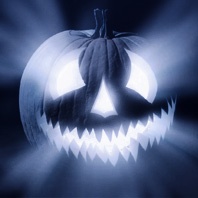
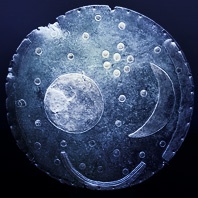

 We are approaching a more sinister subject, the werewolf, a being that apparently changes from human into a wolf on the full moon. Everyone has heard about it or seen more or less plausible interpretations in movies. Where does this belief stem from? Why a wolf of all animals? And why in the full moon light?
We are approaching a more sinister subject, the werewolf, a being that apparently changes from human into a wolf on the full moon. Everyone has heard about it or seen more or less plausible interpretations in movies. Where does this belief stem from? Why a wolf of all animals? And why in the full moon light?